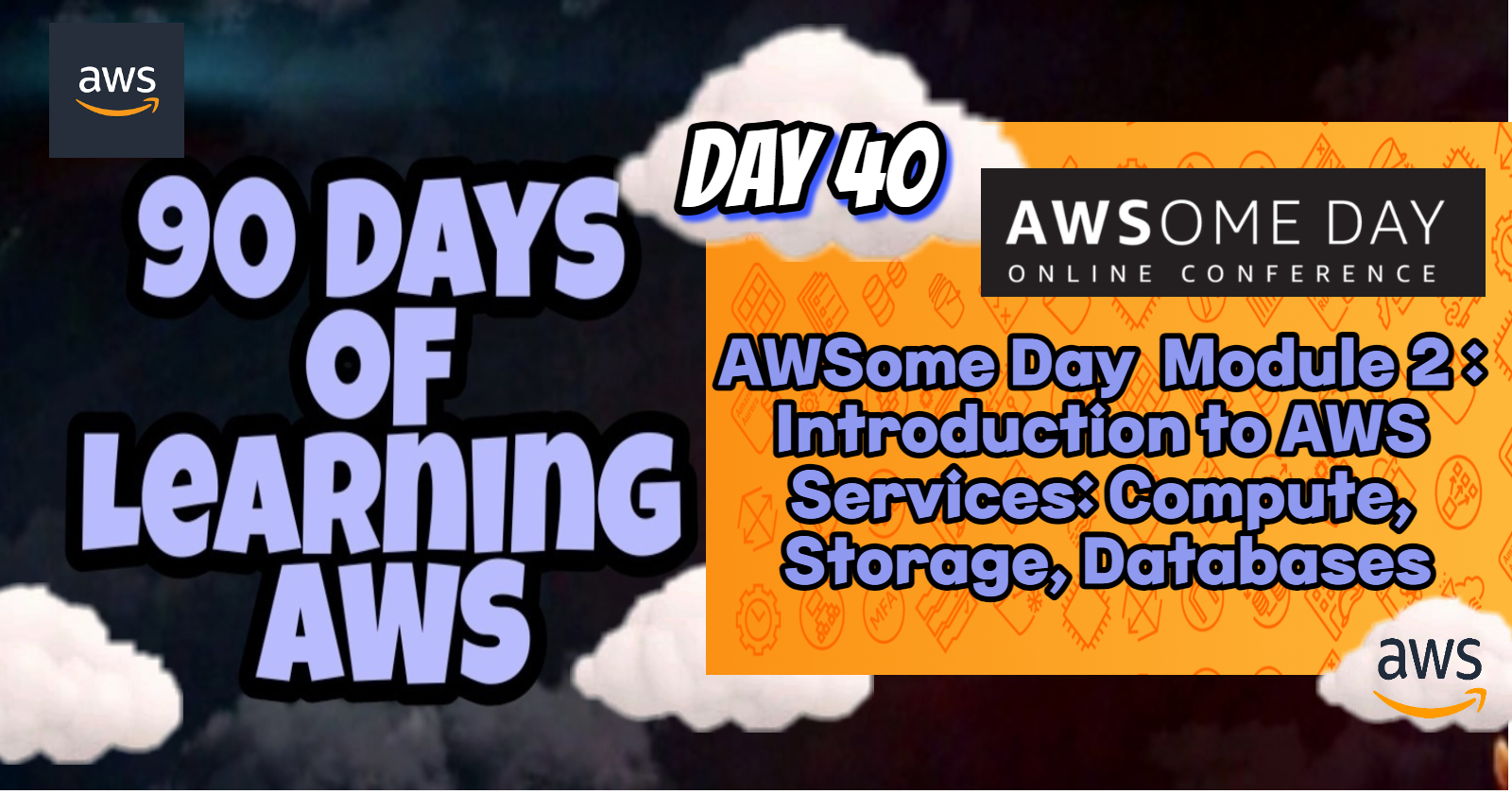Day 40: AWSome Day | On-Demand - Module 2 - Introduction to AWS Services: Compute, Storage, Databases♻
 Shailesh
Shailesh
Introduction
This module dives into the core AWS services related to compute, storage, and databases. It explains the functionalities and use cases of services such as Amazon EC2, Amazon S3, and Amazon RDS, highlighting their benefits and how they integrate into the AWS ecosystem.
Most Important Learning Highlights from Module 2✨
💠Amazon EC2: EC2 offers flexible compute capacity in the cloud, making it easy to scale your computing power up or down based on your needs. It helps you run applications efficiently and cost-effectively. EC2 is extensively covered in our Day 9: Step-by-Step Guide: Creating an EC2 Instance to Host a 'Hello, World' Website🌐 blog.
💠Instance Types: EC2 provides different instance types tailored for various tasks, such as general-purpose, compute-optimized, and memory-optimized instances. This ensures you have the right resources for your specific workload.
💠Amazon S3: S3 is a scalable object storage service designed for storing and retrieving unlimited amounts of data from anywhere on the internet. It's ideal for data backup, content storage, and sharing large files.
💠Storage Classes: S3 offers multiple storage classes to match different data access needs, including Standard for frequent access, Intelligent-Tiering for automatic cost savings, and Glacier for long-term archival storage.
💠Amazon RDS: RDS is a managed relational database service that supports various database engines like MySQL, PostgreSQL, Oracle, and SQL Server. It simplifies database management tasks like backups and patching. You can revisit our blog Day 25: Amazon RDS: Step-by-Step Hands-On Guide with AWS Console ☑ on RDS service hands on.
💠Amazon Aurora: Aurora is a cloud-native, MySQL and PostgreSQL-compatible database that delivers high performance and availability. It automatically grows storage as needed, up to 64TB. We have already covered this in Day 27: Amazon Aurora: A High-Performance, Fully Managed Relational Database✅
💠Amazon DynamoDB: DynamoDB is a fully managed NoSQL database service known for its fast, consistent performance and seamless scalability. It’s great for applications requiring low-latency data access.
💠Amazon Redshift: Redshift is a fast, fully managed data warehouse service that makes it easy to analyze large amounts of data using standard SQL. It's cost-effective and integrates well with other AWS services.
💠Elasticity and Auto Scaling: AWS services can automatically scale resources based on demand, ensuring that you always have the right amount of resources at the right time, which helps optimize performance and cost. Our detailed blog Day 23: Understanding Auto Scaling Groups📈 and Their Policies📑covers this in detail.
💠Backup and Recovery: AWS offers built-in backup and recovery solutions to protect your data and ensure business continuity. These tools help you recover quickly from data loss or disasters. Our Day 29: Comprehensive Backup🔙 and Restore🔁Strategies for Amazon RDS and Aurora Databases🛢✨ blog already covers this topic.
Conclusion💡
The topics covered in this module was revision of most of the services we have studied and documented in our 90 Days Challenge - AWS Certification blog. Stay tuned for more AWS insights!!⚜ If you found this blog helpful, share it with your network! 🌐😊
Happy cloud computing! ☁️🚀
Subscribe to my newsletter
Read articles from Shailesh directly inside your inbox. Subscribe to the newsletter, and don't miss out.
Written by

Shailesh
Shailesh
As a Solution Architect, I am responsible for designing and implementing scalable, secure, and efficient IT solutions. My key responsibilities include: 🔸Analysing business requirements and translating them into technical solutions. 🔸Developing comprehensive architectural plans to meet organizational goals. 🔸Ensuring seamless integration of new technologies with existing systems. 🔸Overseeing the implementation of projects to ensure alignment with design. 🔸Providing technical leadership and guidance to development teams. 🔸Conducting performance assessments and optimizing solutions for efficiency. 🔸Maintaining a keen focus on security, compliance, and best practices. Actively exploring new technologies and continuously refining strategies to drive innovation and excellence.